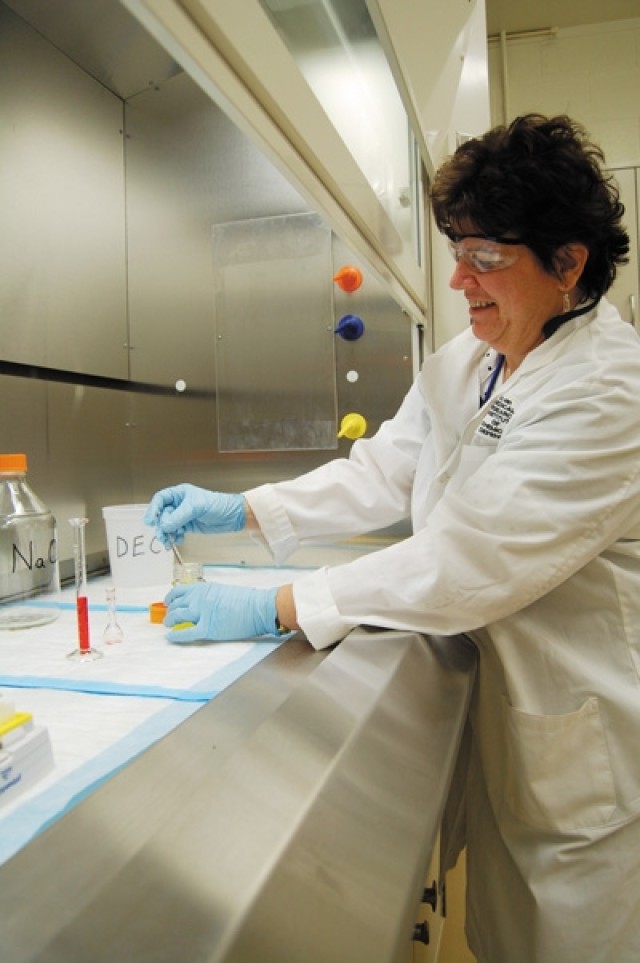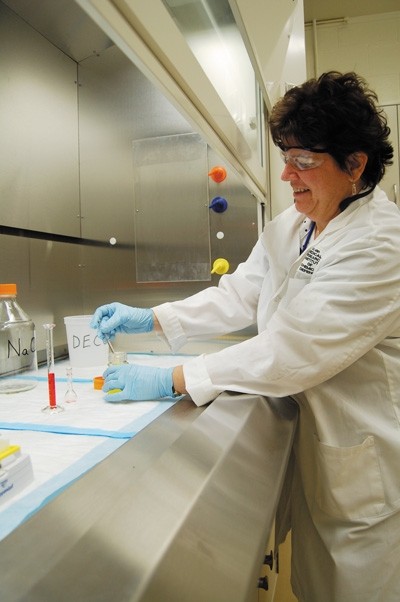
What was once a barn for goats is now a place where scientists on the forefront of chemical defense research try and test their theories to help protect and heal the nation's Warfighters.
A sturdy 6,800 square foot structure made of cement blocks, the barn was transformed into the U.S. Army Medical Research Institute of Chemical Defense's Collaborative Research Facility, part of the U.S. Army Medical Research and Materiel Command, at Aberdeen Proving Ground.
The three new labs in the renovated building are within the scope of ICD's comprehensive Collaborate Research Program, which brings in ideas from scientists outside the institute who could develop improvements to help protect service members from possible chemical weapons attacks.
"The collaborative research here leads to countermeasures to protect the Soldiers and ultimately protects the nation," said Capt. Jeremy Goodin, Research Collaboration Program director.
The facility is expected to enhance the program's ability to accommodate work with other organizations, allowing a steady flow of scientific ingenuity. By using ICD scientists, who are part of only a handful in the world certified to handle the strongest chemicals, they can get their theories tested, Goodin said.
The Army expertise is becoming more and more sought after in research communities around the country. Just five years ago, there were only 23 collaborations, and this year the chemical defense program already has 101 projects in the works from dozens of other groups.
"From 2003 to 2008 the collaboration program skyrocketed," Goodin said. "We stood up the CRF to accommodate the needs and interests of investigators."
Many times researchers at institutes like universities, government agencies and other military laboratories will have promising results in a bio-chemical experiment but will not have the authority to test their theories on chemical agents due to stringent safety requirements. That's where the collaboration program comes in. The other agency will coordinate with the principal investigators at ICD to safely perform the portion of their experiments that require chemical agent.
"I don't think collaborative research anywhere else in the military is like it is here. It's a really good deal for them and us," said Dr. Jack Baggett, chief of ICD's Program Strategies and Operations Office. "Although the amount of time to get a project done is a little on the long end compared to the outside research facilities, it's because we are much more careful. We don't rush anything."
Baggett said the collaboration program as well as all the research conducted in ICD's 10 other buildings and laboratories ensures science performed by the ICD investigators is verifiable through rigorous testing and documentation. That way, the scientists who submitted their work will know that it can be published and shared with the broader scientific community.
"Collaboration is the way to go," Goodin said. "As a researcher, I've always worked with people in academia. It increases research exponentially and helps publish more papers."
But not everyone who wants their theories tested by ICD will get the chance to use the principal investigators and facilities. Potential collaborators submit their request, and if the research is found beneficial for protecting or treating service members, it may get picked up. The other agencies also pay a fee for the Army's ability.
"We don't approve everything that comes through our door," Baggett said. "If it doesn't fit our mission, we're not going to do it."
Since the program gets so many requests, the MRICD researchers can be very selective and concentrate on experiments that will have the broadest benefits to the country.
"We're not a for-profit laboratory," Baggett said. "I'd rather have someone doing one to three experiments extremely well than just getting six done."
Benefiting from collaboration on a number of projects with ICD, Dr. Richard Gordon at MRMC's Walter Reed Army Institute of Research in Silver Spring, Md., said he very much appreciates his more than 10-year-old working relationship.
As one of his partnership projects, he and an ICD investigator will be delving into decontaminating and detoxifying sponges for chemically exposed skin.
"We have a group of people who want to do some of the same research at ICD as at WRAIR, but we can't work with the chemical agents," Gordon said. "We're on equal footing with the science but go there to execute."

Social Sharing